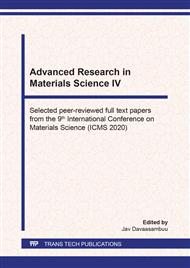[1]
Ouvinha de Oliveira R, de Santa Maria LC, Barratt G., Ann Pharm Fr (2014), 72, 303–16.
Google Scholar
[2]
S. A. RASHDAN AND L. J. HAZEEM, Arab Journal of Basic and Applied Sciences, (2020).
Google Scholar
[3]
S. Kanagesan, M. Hashim, et al., Journal of Nanomaterials, (2013), 1-8.
Google Scholar
[4]
Ahamed, M., Akhtar, M. J., Alhadlaq, H. A., Khan, M. A., & Alrokayan, S. A. (2015), Chemosphere, 135, 278–288.
Google Scholar
[5]
Ahamed, M., Akhtar, M. J., Alhadlaq, H. A., & Alshamsan, A. (2016), Colloids and Surfaces B: Biointerfaces, 142, 46–54.
DOI: 10.1016/j.colsurfb.2016.02.043
Google Scholar
[6]
Alhadlaq, H. A., Akhtar, M. J., & Ahamed, M. (2015), Cell & Bioscience, 5, 55.
Google Scholar
[7]
Kim, D. H., Kim, K. N., Kim, K. M., Shim, I. B., & Lee, Y. K. (2007), NSTI-Nanotech, 2, 748–751.
Google Scholar
[8]
Tomitaka, A., Hirukawa, A., Yamada, T., Morishita, S., Takemura, Y., 2009, J. Magn. Magn. Mater. 321, 1482–1484.
Google Scholar
[9]
Zhao Q, Wang L, Cheng R, et al., Theranostics, (2012), 2(1), 113–121.
Google Scholar
[10]
B. Sahoo, K. S. P. Devi, S. Dutta, T. K. Maiti, P. Pramanik, D. Dhara, J. Colloid Interface Sci. (2014), 431, 31.
Google Scholar
[11]
J. Jimenez, L.R. Negrete, F. Abdullaev, et al., Exp. Toxicol. Pathol. 60 (2008).
Google Scholar
[12]
Peppino Mirabelli, Luigi Coppola, Marco Salvatore, Cancers (Basel), (2019) Aug 11(8): 1098.
Google Scholar
[13]
I. Khishigdemberel, E. Uyanga, et al., Solid State Sciences 109 (2020) 106400.
Google Scholar
[14]
Stayton I, Winiarz J, Shannon K, et al. Study of uptake and loss of silica nanoparticles in living human lung epithelial cells at single cell level. Anal Bioanal Chem 2009; 394: 1595–1608.
DOI: 10.1007/s00216-009-2839-0
Google Scholar
[15]
T. Saga, H. Sakahara, Y. Nakamoto, et al., Eur. J. Cancer 37 (2001) 1429.
Google Scholar
[16]
N. Siva Kumar, S.R.P. Gnanakan, K. Karthikeyan, S. Amaresh, W.S. Yoon, G.J. Park, Y.S. Lee, J. Alloys Compd. 509, 7038 (2011).
Google Scholar
[17]
F. Novelo, R. Valenzuela, Mater. Res. Bull. 30, 335 (1995).
Google Scholar
[18]
G. F. Yang, X. H. Li, Z. Zhao, W. B. Wang, Acta. Pharmacol. Sin. 30, (2009) 1688.
Google Scholar


